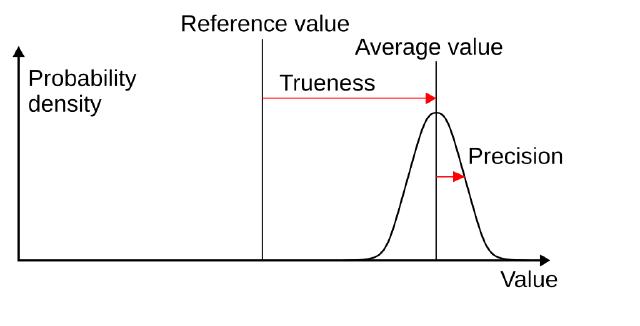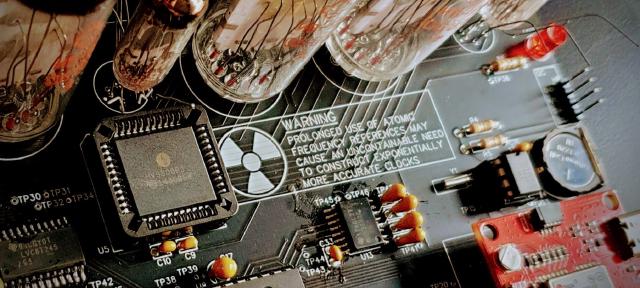“Accuracy is, in every case, advantageous to beauty” - David Hume
Understanding accuracy
In short, what makes a good clock is an accurate one! Whereby accuracy is derived from a combination of precision and trueness:
ISO 5725-1 definition of accuracy
Here the reference value is usually the ideal and assumed frequency of our oscillator. For a pendulum clock that swings once per second, this would be 1Hz. For a quartz crystal, this may be an electronic signal that changes state 40,000,000 times a second, or 40MHz.
Precision
Precision in this case is the consistency of our measured value, this usually a property of the oscillator component of the clock, however the other components may also affect our ability to measure this.
- In an hour glass, the rate at which grains of sand fall through the neck is in part determined by the size of the grains. If all the grains are the same size, the sand will flow consistently, giving high precision. However if the grains vary in size, then the flow rate will vary depending on which grains pass through, giving poor precision.
- In an electronic clock, the mechanism in software that counts the ticks may be poorly designed, and may run inconsistently. So whilst the frequency source may be highly precise, the mechanism by which it is measured and counted has low precision.
Both of these scenarios will result in poor precision and a wider spread of the probability density curve on the diagram above, but will not change the distance of the centre of the curve from the reference value.
Trueness
Trueness is the deviation of our sample group from our assumed reference value.
- In the case of a pendulum, it may be that all measured ticks are the same length, giving very high precision, but instead of being 1 second long, they are 1.1 seconds long. This will result in poor accuracy as a result of poor trueness.
- The frequency of an otherwise perfect quartz crystal will vary with temperature. A rise of 20°C may cause the grouping of samples to move by 0.01%, or 100ppm. This may not sound like much, but will translate to a 8.64 second deviation each day, summing to over 50 minutes a year if left uncorrected.
- The display technology in use may have a degree of latency. Mechanical flip digits for instance take an appreciable portion of a second to arrive at the next number.
Poor trueness will move the probability density curve on the diagram further away from the reference value, without changing the shape of the curve.
Improving accuracy
Given the concepts outlined above, there are several steps that can be taken to improve the accuracy of a given clock.
Sample size
A larger sample size has the potential to improve the accuracy of a clock to compensate for low precision, improving long term accuracy. Depending on the source of the poor precision, this can either be done as long term average as per the hour glass example, or potentially over a much smaller time period for electronic signals.
Second reference source
Trueness may be improved by comparing the clock to a known reference value and then applying an offset to bring the measured value closer to the reference value. In the pendulum example, the adjustment can be made by measuring against a known good clock to determine the trueness and performing calculations to determine the change in length required to bring the pendulum close to the reference value.
Clock characterisation
If there is a known source of latency in the system that is affecting the trueness, characterising the latency of the relevant part of the system allows a compensation factor to be applied. In the flip digit example, if each flip is known to take 0.2 seconds, the signal to change ot the next number can be sent 0.2 seconds early so the new digit is displayed on time.
In another example, if a quartz crystal has a known deviation per unit of temperature, a temperature sensor can be placed close to the quartz crystal and a compensation factor applied to maintain a fixed frequency that is less impacted by temperature changes.
All of the above
Very rarely are there cases whereby a clock is deficient in only one area. A good design for an accurate clock will take most of the above into consideration to arrive at an optimal solution for a given set of success criteria.

